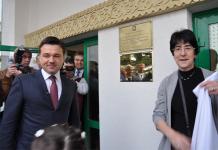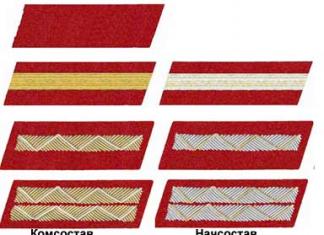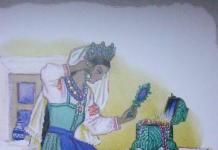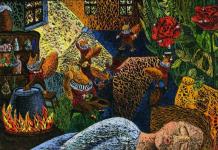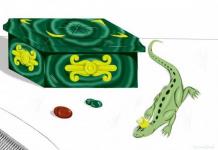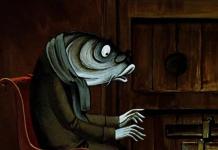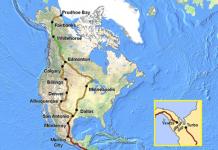MICROSCOPE
REPORT on Biology of a 6th grade student
For a long time, a person lived surrounded by invisible creatures, used their waste products (for example, when baking bread from sour dough, making wine and vinegar), suffered when these creatures caused illnesses or spoiled food supplies, but did not suspect their presence . I didn't suspect because I didn't see it, and I didn't see it because the sizes of these micro creatures were much lower than the limit of visibility that the human eye is capable of. It is known that a person with normal vision at the optimal distance (25–30 cm) can distinguish an object 0.07–0.08 mm in size in the form of a point. Smaller objects cannot be seen. This is determined by the structural features of his organ of vision.
Approximately at the same time when the exploration of space with the help of telescopes began, the first attempts were made to reveal, with the help of lenses, the secrets of the microworld. So, during archaeological excavations in Ancient Babylon, biconvex lenses were found - the simplest optical devices. The lenses were made from polished mountain crystal. It can be considered that with their invention man took the first step on the way to the microworld.
The simplest way to enlarge the image of a small object is to observe it with a magnifying glass. A magnifying glass is a converging lens with a small focal length (usually no more than 10 cm) inserted into the handle.
telescope maker Galileo in 1610
In 1993, he discovered that, when wide apart, his spotting scope made it possible to greatly enlarge small objects. It can be considered the inventor of the microscope consisting of positive and negative lenses.
A more advanced tool for observing microscopic objects is simple microscope. When these devices appeared, it is not known exactly. At the very beginning of the 17th century, several such microscopes were made by a spectacle craftsman Zacharias Jansen from Middelburg.
In the essay A. Kircher, released in 1646 year, contains a description the simplest microscope named by him "flea glass". It consisted of a magnifying glass embedded in a copper base, on which an object table was fixed, which served to place the object in question; at the bottom there was a flat or concave mirror, reflecting the sun's rays onto an object and thus illuminating it from below. The magnifying glass was moved by means of a screw to the object table until the image became distinct and clear.
First great discoveries were just made using a simple microscope. In the middle of the 17th century, brilliant success was achieved by the Dutch naturalist Anthony Van Leeuwenhoek. For many years Leeuwenhoek perfected himself in the manufacture of tiny (sometimes less than 1 mm in diameter) biconvex lenses, which he made from a small glass ball, which in turn was obtained by melting a glass rod in a flame. Then this glass ball was ground on a primitive grinding machine. During his life, Leeuwenhoek made at least 400 such microscopes. One of them, kept in the University Museum in Utrecht, gives more than 300x magnification, which was a huge success for the 17th century.
At the beginning of the 17th century, there were compound microscopes composed of two lenses. The inventor of such a complex microscope is not exactly known, but many facts indicate that he was a Dutchman. Cornelius Drebel, who lived in London and was in the service of the English King James I. In the compound microscope, there was two glasses: one - the lens - facing the object, the other - the eyepiece - facing the eye of the observer. In the first microscopes, a biconvex glass served as an objective, which gave a real, enlarged, but inverse image. This image was examined with the help of an eyepiece, which thus played the role of a magnifying glass, but only this magnifying glass served to magnify not the object itself, but its image.
V 1663 microscope Drebel was improved English physicist Robert Hooke, who introduced a third lens into it, called the collective. This type of microscope gained great popularity, and most of the microscopes of the late 17th - first half of the 8th century were built according to its scheme.
Microscope device
A microscope is an optical instrument designed to study magnified images of micro-objects that are invisible to the naked eye.
The main parts of a light microscope (Fig. 1) are an objective and an eyepiece enclosed in a cylindrical body - a tube. Most models designed for biological research come with three lenses with different focal lengths and a rotating mechanism designed for quick change - a turret, often called a turret. The tube is located on the top of a massive stand, including the tube holder. Slightly below the objective (or turret with multiple objectives) is an object stage, on which slides with test samples are placed. Sharpness is adjusted using a coarse and fine adjustment screw, which allows you to change the position of the stage relative to the objective.
In order for the sample under study to have sufficient brightness for comfortable observation, the microscopes are equipped with two more optical units (Fig. 2) - an illuminator and a condenser. The illuminator creates a stream of light that illuminates the test preparation. In classical light microscopes, the design of the illuminator (built-in or external) involves a low-voltage lamp with a thick filament, a converging lens, and a diaphragm that changes the diameter of the light spot on the sample. The condenser, which is a converging lens, is designed to focus the illuminator beams on the sample. The condenser also has an iris diaphragm (field and aperture), which controls the intensity of illumination.
When working with light-transmitting objects (liquids, thin sections of plants, etc.), they are illuminated by transmitted light - the illuminator and condenser are located under the object stage. Opaque samples should be illuminated from the front. To do this, the illuminator is placed above the object stage, and its beams are directed to the object through the lens using a translucent mirror.
The illuminator may be passive, active (lamp), or both. The simplest microscopes do not have lamps to illuminate samples. Under the table they have a double-sided mirror, in which one side is flat and the other is concave. In daylight, if the microscope is near a window, you can get pretty good illumination using a concave mirror. If the microscope is in a dark room, a flat mirror and an external illuminator are used for illumination.
The magnification of a microscope is equal to the product of the magnification of the objective and the eyepiece. With an eyepiece magnification of 10 and an objective magnification of 40, the total magnification factor is 400. Usually, objectives with a magnification of 4 to 100 are included in a research microscope kit. A typical microscope objective kit for amateur and educational research (x4, x10 and x40), provides increase from 40 to 400.
Resolution is different the most important characteristic microscope, which determines its quality and the clarity of the image it forms. The higher the resolution, the more fine details can be seen at high magnification. In connection with resolution, one speaks of "useful" and "useless" magnification. “Useful” is the maximum magnification at which the maximum image detail is provided. Further magnification (“useless”) is not supported by the resolution of the microscope and does not reveal new details, but it can negatively affect the clarity and contrast of the image. Thus, the limit of useful magnification of a light microscope is not limited by the overall magnification factor of the objective and the eyepiece - it can be made arbitrarily large if desired - but by the quality of the optical components of the microscope, that is, the resolution.
The microscope includes three main functional parts:
1. Lighting part
Designed to create a light flux that allows you to illuminate the object in such a way that the subsequent parts of the microscope perform their functions with the utmost accuracy. The illuminating part of a transmitted light microscope is located behind the object under the objective in direct microscopes and in front of the object above the objective in inverted ones.
The lighting part includes a light source (a lamp and an electric power supply) and an optical-mechanical system (collector, condenser, field and aperture adjustable / iris diaphragms).
2. Playback part
Designed to reproduce an object in the image plane with the image quality and magnification required for research (i.e., to build such an image that reproduces the object as accurately as possible and in all details with the resolution, magnification, contrast and color reproduction corresponding to the microscope optics).
The reproducing part provides the first stage of magnification and is located after the object to the image plane of the microscope. The reproducing part includes a lens and an intermediate optical system.
Modern microscopes of the latest generation are based on optical systems of lenses corrected for infinity.
This additionally requires the use of so-called tube systems, which “collect” parallel beams of light coming out of the objective in the image plane of the microscope.
3. Visualizing part
Designed to obtain a real image of the object on the retina, film or plate, on the screen of a television or computer monitor with additional magnification (the second stage of magnification).
The imaging part is located between the image plane of the lens and the eyes of the observer (camera, camera).
The imaging part includes a monocular, binocular or trinocular visual attachment with an observation system (eyepieces that work like a magnifying glass).
In addition, this part includes systems of additional magnification (systems of a wholesaler / change of magnification); projection nozzles, including discussion nozzles for two or more observers; drawing devices; image analysis and documentation systems with appropriate matching elements (photo channel).
First microscopists second half of the 17th century. - physicist R. Hooke, anatomist M. Malpighi, botanist N. Gru, amateur optician A. Leeuwenhoek and others described the structure of the skin, spleen, blood, muscles, seminal fluid, etc. using a microscope. Each study was essentially a discovery, which did not get along well with the metaphysical view of nature that has evolved over the centuries. The random nature of the discoveries, the imperfection of microscopes, the metaphysical worldview did not allow for 100 years (from the middle of the 17th century to the middle of the 18th century) to make significant steps forward in the knowledge of the laws of the structure of animals and plants, although attempts were made to generalize (theories of "fibrous" and " granular structure of organisms, etc.).
The discovery of the cellular structure occurred at a time in the development of mankind, when experimental physics began to claim to be called the mistress of all sciences. In London, a society of the greatest scientists was created, who focused on improving the world on specific physical laws. At the meetings of the community members, there were no political debates, only various experiments were discussed and research on physics and mechanics was shared. Times were turbulent then, and scientists observed very strict secrecy. The new community began to be called the "college of the invisible." The first who stood at the origins of the creation of the society was Robert Boyle, Hooke's great mentor. The Board produced the necessary scientific literature. The author of one of the books was Robert Hook, who was also a member of this secret scientific community. Hooke already in those years was known as the inventor of interesting devices that made it possible to make great discoveries. One of these devices was microscope.
One of the first creators of the microscope was Zacharius Jansen who created it in 1595. The idea of the invention was that two lenses (convex) were mounted inside a special tube with a retractable tube to focus the image. This device could increase the studied objects by 3-10 times. Robert Hooke improved this product, which played a major role in the upcoming discovery.
Robert Hooke for a long time observed various small specimens through the created microscope, and once he took an ordinary cork from a vessel for viewing. Having examined a thin section of this cork, the scientist was surprised at the complexity of the structure of the substance. An interesting pattern of many cells appeared to his eyes, surprisingly similar to a honeycomb. Since cork is a vegetable product, Hooke began to study sections of plant stems with a microscope. Everywhere a similar picture was repeated - a set of honeycombs. The microscope showed many rows of cells, which were separated by thin walls. Robert Hooke called these cells cells. Subsequently, a whole science of cells was formed, which is called cytology. Cytology includes the study of the structure of cells and their vital activity. This science is used in many areas, including medicine and industry.
With name M. Malpighi This outstanding biologist and physician is associated with an important period of microscopic studies of the anatomy of animals and plants.
The invention and improvement of the microscope allowed scientists to discover
a world of extremely small creatures, completely different from those
which are visible to the naked eye. Having received a microscope, Malpighi made a number of important biological discoveries. At first he considered
everything that came to hand:
- insects,
- light frogs,
- blood cells,
- capillaries,
- skin,
- liver,
- spleen
- plant tissues.
In the study of these subjects, he reached such perfection that he became
one of the founders of microscopic anatomy. Malpighi was the first to use
microscope for the study of blood circulation.
Using a 180x magnification, Malpighi made a discovery in the theory of blood circulation: looking at a frog lung preparation under a microscope, he noticed air bubbles surrounded by a film, and small blood vessels, saw an extensive network of capillary vessels connecting arteries to veins (1661). Over the next six years, Malpighi made observations that he described in scientific works that brought him fame as a great scientist. Malpighi's reports on the structure of the brain, tongue, retina, nerves, spleen, liver, skin, and on the development of the embryo in a chicken egg, as well as on the anatomical structure of plants, testify to very careful observations.
Nehemiah Gru(1641 - 1712). English botanist and physician, microscopist,
founder of plant anatomy. The main works are devoted to the issues of structure and gender of plants. Along with M. Malpighi was the founder
plant anatomy. First described:
- stomata,
- radial arrangement of xylem in roots,
- morphology of vascular tissue in the form of a dense formation in the center of the stem of a young plant,
- the process of forming a hollow cylinder in old stems.
He introduced the term "comparative anatomy", introduced the concepts of "tissue" and "parenchyma" into botany. Studying the structure of flowers, I came to the conclusion that they are the organs of fertilization in plants.
Leeuwenhoek Anthony(October 24, 1632–August 26, 1723), Dutch naturalist. He worked in a textile shop in Amsterdam. Back in Delft, free time engaged in lens grinding. In total, during his life, Leeuwenhoek made about 250 lenses, achieving a 300-fold increase and achieved great perfection in this. The lenses he made, which he inserted into metal holders with a needle attached to them to put the object of observation, gave a magnification of 150–300 times. With the help of such "microscopes" Leeuwenhoek first observed and sketched:
- spermatozoa (1677),
- bacteria (1683),
- erythrocytes,
- protozoa,
- individual plant and animal cells,
- eggs and fetuses
- muscle tissue,
- many other parts and organs of more than 200 species of plants and animals.
First described parthenogenesis in aphids (1695–1700).
Leeuwenhoek stood on the positions of preformism, arguing that the formed embryo is already contained in the "animalcule" (spermatozoon). He denied the possibility of spontaneous generation. He described his observations in letters (up to 300 in total), which he sent mainly to the Royal Society of London. Following the movement of blood through the capillaries, he showed that capillaries connect arteries and veins. For the first time he observed erythrocytes and found that in birds, fish and frogs they have an oval shape, while in humans and other mammals they are disc-shaped. He discovered and described rotifers and a number of other small freshwater organisms.
The use of an achromatic microscope in scientific research served as a new impetus for the development of histology. At the beginning of the XIX century. the first image of plant cell nuclei was made. J. Purkinje(in 1825-1827) described the nucleus in the ovum of a chicken, and then the nuclei in the cells of various animal tissues. Later, he introduced the concept of "protoplasm" (cytoplasm) of cells, characterized the shape of nerve cells, the structure of glands, etc.
R. Brown concluded that the nucleus is an essential part of the plant cell. Thus, gradually began to accumulate material on the microscopic organization of animals and plants and the structure of "cells" (cellula), seen for the first time by R. Hooke.
The creation of the cell theory had a huge progressive impact on the development of biology and medicine. In the middle of the XIX century. began a period of rapid development of descriptive histology. Based on the cellular theory, the composition of various organs and tissues and their development were studied, which made it possible even then to create a microscopic anatomy in basic terms and to refine the classification of tissues, taking into account their microscopic structure (A. Kölliker and others).
Nowadays modern technologies widely used in many areas human activity. For example, in medicine there are already many devices that help put a person on his feet. But still, despite the great leap in the development of technology, in medicine there are many tools that have no analogues, and which cannot be replaced by something else.
One such tool is the research biological microscope, which is actively used both in clinical practice and in the microbiological laboratory. Even modern devices do not have the functions and capabilities that a microscope has, for example, in microbiological research or blood cell analysis.
 To date, biomedical microscopes are the most popular type of optical equipment. These tools can be used in any research that is related to the study of objects of natural origin. Microscopes of this type are divided into two types: research and biological laboratories. And also for routine and workers. The biological microscope is mainly used in various research centers, scientific institutions or hospitals.
To date, biomedical microscopes are the most popular type of optical equipment. These tools can be used in any research that is related to the study of objects of natural origin. Microscopes of this type are divided into two types: research and biological laboratories. And also for routine and workers. The biological microscope is mainly used in various research centers, scientific institutions or hospitals.
I would also like to talk about binocular microscopes, which are a new stage in the evolution of these instruments. These devices have two eyepieces, which makes it much easier to work, and the work becomes more comfortable.
Today it is simply irreplaceable in hospitals or scientific laboratories. These microscopes will be a good purchase for students of higher educational institutions who simply need to practice in different academic jobs in order to gain experience.
With the help of two eyepieces, it will be very easy to examine the experimental object, moreover, the quality of the object under consideration, thanks to the eyepieces, will increase several times. One of the main advantages of this apparatus is that modern cameras or cameras can be attached to it, and as a result, images of the object, or microscopic photography, can be obtained.
When you choose this device for yourself, first of all, pay attention to the following details, parameters and features: a revolver with multiple lenses, lighting options, ways to move the stage. In addition, the microscope can be equipped with additional accessories such as lamps, objectives, eyepieces, etc.
This is the science of life. At present, it represents the totality of the sciences of living nature.
Biology studies all manifestations of life: structure, functions, development and origin living organisms, their relationship in natural communities with the environment and with other living organisms.
Since man began to realize his difference from the animal world, he began to study the world around him.
At first, his life depended on it. Primitive people it was necessary to know which living organisms could be eaten, used as medicines, for making clothes and dwellings, and which of them were poisonous or dangerous.
With the development of civilization, a person could afford such a luxury as doing science for educational purposes.
Research the cultures of the ancient peoples showed that they had extensive knowledge about plants and animals and widely applied them in everyday life.
Modern biology - complex the science, which is characterized by the interpenetration of ideas and methods of various biological disciplines, as well as other sciences - primarily physics, chemistry and mathematics.
The main directions of development of modern biology. Currently, three directions in biology can be conditionally distinguished.
First, it is classical biology. It is represented by natural scientists who study the diversity of living nature. They objectively observe and analyze everything that happens in wildlife, study living organisms and classify them. It is wrong to think that in classical biology all discoveries have already been made.
In the second half of the XX century. not only many new species have been described, but also large taxa have been discovered, up to kingdoms (Pogonophores) and even superkingdoms (Archaebacteria, or Archaea). These discoveries forced scientists to take a fresh look at the entire development history living nature, For true natural scientists, nature is a value in itself. Every corner of our planet is unique for them. That is why they are always among those who acutely feel the danger to the nature around us and actively advocate for it.
The second direction is evolutionary biology.
In the 19th century the author of the theory of natural selection, Charles Darwin, began as an ordinary naturalist: he collected, observed, described, traveled, revealing the secrets of wildlife. However, the main result of his work that made him a famous scientist was the theory explaining organic diversity.

Currently, the study of the evolution of living organisms is actively continuing. The synthesis of genetics and evolutionary theory led to the creation of the so-called synthetic theory of evolution. But even now there are still many unresolved questions that evolutionary scientists are looking for answers to.

Created at the beginning of the 20th century. by our outstanding biologist Alexander Ivanovich Oparin, the first scientific theory of the origin of life was purely theoretical. Currently, experimental studies of this problem are being actively conducted, and thanks to the use of advanced physicochemical methods, important discoveries have already been made and new interesting results can be expected.
New discoveries made it possible to supplement the theory of anthropogenesis. But the transition from the animal world to man still remains one of the most big mysteries biology.

The third direction is physical and chemical biology, which studies the structure of living objects using modern physical and chemical methods. This is a rapidly developing area of biology, important both in theoretical and practical terms. We can say with confidence that new discoveries await us in physical and chemical biology, which will allow us to solve many problems facing humanity.

The development of biology as a science. Modern biology is rooted in antiquity and is associated with the development of civilization in the Mediterranean countries. We know the names of many outstanding scientists who contributed to the development of biology. Let's name just a few of them.
Hippocrates (460 - c. 370 BC) gave the first relatively detailed description of the structure of man and animals, pointed out the role of the environment and heredity in the occurrence of diseases. He is considered the founder of medicine.

Aristotle (384-322 BC) divided the world into four kingdoms: the inanimate world of earth, water and air; plant world; the animal world and the human world. He described many animals, laid the foundation for taxonomy. The four biological treatises he wrote contained almost all the information about animals known by that time. The merits of Aristotle are so great that he is considered the founder of zoology.
Theophrastus (372-287 BC) studied plants. He described more than 500 plant species, gave information about the structure and reproduction of many of them, introduced many botanical terms. He is considered the founder of botany.

Gaius Pliny the Elder (23-79) collected information about living organisms known by that time and wrote 37 volumes of the Natural History Encyclopedia. Almost until the Middle Ages, this encyclopedia was the main source of knowledge about nature.
Claudius Galen made extensive use of dissections of mammals in his scientific research. He was the first to make a comparative anatomical description of man and monkey. Studied central and peripheral nervous system. Historians of science consider him the last great biologist of antiquity.
In the Middle Ages, religion was the dominant ideology. Like other sciences, biology during this period had not yet emerged as a independent region and existed in the general mainstream of religious and philosophical views. And although the accumulation of knowledge about living organisms continued, one can speak of biology as a science at that time only conditionally.
The Renaissance is a transitional period from the culture of the Middle Ages to the culture of modern times. The fundamental socio-economic transformations of that time were accompanied by new discoveries in science.
The most famous scientist of this era, Leonardo da Vinci (1452 - 1519), made a certain contribution to the development of biology.
He studied the flight of birds, described many plants, ways of connecting bones in the joints, the activity of the heart and the visual function of the eye, the similarity of human and animal bones.
In the second half of the XV century. natural sciences begin to develop rapidly. This was facilitated by geographical discoveries, which made it possible to significantly expand information about animals and plants. The rapid accumulation of scientific knowledge about living organisms led to the division of biology into separate sciences.
In the XVI-XVII centuries. Botany and zoology began to develop rapidly.
The invention of the microscope (early 17th century) made it possible to study the microscopic structure of plants and animals. Microscopically small living organisms, bacteria and protozoa, invisible to the naked eye, were discovered.
A great contribution to the development of biology was made by Carl Linnaeus, who proposed a classification system for animals and plants,
Karl Maximovich Baer (1792-1876) in his works formulated the main provisions of the theory of homologous organs and the law of germinal similarity, which laid the scientific foundations of embryology.
In 1808, in his Philosophy of Zoology, Jean-Baptiste Lamarck raised the question of the causes and mechanisms of evolutionary transformations and outlined the first theory of evolution in time.
The cell theory played a huge role in the development of biology, which scientifically confirmed the unity of the living world and served as one of the prerequisites for the emergence of Charles Darwin's theory of evolution. The zoologist Theodor Ivann (1818-1882) and the botanist Matthias Jakob Schleiden (1804-1881) are considered the authors of the cell theory.
On the basis of numerous observations, Charles Darwin published in 1859 his main work “On the Origin of Species by Means of Natural Selection, or the Preservation of Favored Breeds in the Struggle for Life”, in which he formulated the main provisions of the theory of evolution, proposed the mechanisms of evolution and ways of evolutionary transformations of organisms.
In the 19th century Thanks to the work of Louis Pasteur (1822-1895), Robert Koch (1843-1910), Ilya Ilyich Mechnikov, microbiology took shape as an independent science.
The 20th century began with the rediscovery of Gregor Mendel's laws, which marked the beginning of the development of genetics as a science.
In the 40-50s of the XX century. in biology, the ideas and methods of physics, chemistry, mathematics, cybernetics and other sciences began to be widely used, and microorganisms were used as objects of study. As a result, biophysics, biochemistry, molecular biology, radiation biology, bionics, etc. emerged and rapidly developed as independent sciences. Space exploration contributed to the birth and development of space biology.
In the XX century. the direction of applied research - biotechnology. This trend will undoubtedly develop rapidly in the 21st century. You will learn more about this direction in the development of biology when studying the chapter "Fundamentals of Breeding and Biotechnology".
Currently, biological knowledge is used in all spheres of human activity: in industry and agriculture, medicine and energy.
Ecological research is extremely important. We finally began to realize that the delicate balance that exists on our small planet is easy to destroy. Mankind has faced a daunting task - the preservation of the biosphere in order to maintain the conditions for the existence and development of civilization. It is impossible to solve it without biological knowledge and special studies. Thus, at present, biology has become a real productive force and a rational scientific basis for the relationship between man and nature.
classical biology. Evolutionary biology. Physical and chemical biology.
1. What directions in the development of biology can you single out?
2. What great scientists of antiquity made a significant contribution to the development of biological knowledge?
3. Why in the Middle Ages it was possible to speak about biology as a science only conditionally?
4. Why is modern biology considered a complex science?
5. What is the role of biology in modern society?
6. Prepare a message on one of the following topics:
7. The role of biology in modern society.
8. The role of biology in space research.
9. The role of biological research in modern medicine.
10. The role of outstanding biologists - our compatriots in the development of world biology.
How much the views of scientists on the diversity of living things have changed can be demonstrated by the example of the division of living organisms into kingdoms. Back in the 40s of the XX century, all living organisms were divided into two kingdoms: Plants and Animals. The plant kingdom also included bacteria and fungi. Later, a more detailed study of organisms led to the allocation of four kingdoms: Prokaryotes (Bacteria), Fungi, Plants and Animals. This system is given in school biology.
In 1959, it was proposed to divide the world of living organisms into five kingdoms: Prokaryotes, Protists (Protozoa), Fungi, Plants and Animals.
This system is often given in biological (especially translated) literature.
Other systems have been developed and continue to be developed, including 20 or more kingdoms. For example, it is proposed to distinguish three superkingdoms: Prokaryotes, Archaea (Archaebacteria) and Eukaryotes. Each superkingdom includes several kingdoms.
Kamensky A. A. Biology grade 10-11
Submitted by readers from the website
Online library with students and books, outlines of lessons from Grade 10 Biology, books and textbooks according to the calendar plan planning Biology Grade 10
Lesson content lesson summary and support frame lesson presentation interactive technologies accelerating teaching methods Practice quizzes, testing online tasks and exercises homework workshops and trainings questions for class discussions Illustrations video and audio materials photos, pictures graphics, tables, schemes comics, parables, sayings, crossword puzzles, anecdotes, jokes, quotes Add-onsEveryone knows that biology is the science of life. At present, it represents the totality of the sciences of living nature. Biology studies all manifestations of life: the structure, functions, development and origin of living organisms, their relationships in natural communities with the environment and with other living organisms.
Since man began to realize his difference from the animal world, he began to study the world around him. At first, his life depended on it. Primitive people needed to know which living organisms can be eaten, used as medicines, for making clothes and dwellings, and which of them are poisonous or dangerous.
With the development of civilization, a person could afford such a luxury as doing science for educational purposes.
Studies of the culture of ancient peoples have shown that they had extensive knowledge about plants and animals and widely used them in everyday life.?
Modern biology is a complex science, which is characterized by the interpenetration of ideas and methods of various biological disciplines, as well as other sciences, primarily physics, chemistry, and mathematics.
The main directions of development of modern biology. Currently, three directions in biology can be conditionally distinguished.
First, it is classical biology. It is represented by natural scientists who study the diversity of wildlife. They objectively observe and analyze everything that happens in wildlife, study living organisms and classify them. It is wrong to think that in classical biology all discoveries have already been made. In the second half of the XX century. not only many new species have been described, but also large taxa have been discovered, up to kingdoms (Pogonophores) and even superkingdoms (Archaebacteria, or Archaea). These discoveries forced scientists to take a fresh look at the entire history of the development of wildlife. For true natural scientists, nature is a value in itself. Every corner of our planet is unique for them. That is why they are always among those who acutely feel the danger to the nature around us and actively advocate for it.
The second direction is evolutionary biology. In the 19th century, the author of the theory of natural selection, Charles Darwin, began as an ordinary naturalist: he collected, observed, described, traveled, revealing the secrets of wildlife. However, the main result of his work, which made him a famous scientist, was a theory explaining organic diversity.
Currently, the study of the evolution of living organisms is actively continuing. The synthesis of genetics and evolutionary theory led to the creation of the so-called synthetic theory of evolution. But even now there are still many unresolved questions that evolutionary scientists are looking for answers to.
Created at the beginning of the 20th century. by our outstanding biologist Alexander Ivanovich Oparin, the first scientific theory of the origin of life was purely theoretical. Currently, experimental studies of this problem are being actively conducted, and thanks to the use of advanced physicochemical methods, important discoveries have already been made and new interesting results can be expected.
New discoveries made it possible to supplement the theory of anthropogenesis. But the transition from the animal world to man still remains one of the biggest mysteries of biology.
The third direction is physicochemical biology, which studies the structure of living objects using modern physical and chemical methods. This is a rapidly developing area of biology, important both in theoretical and practical terms. We can say with confidence that new discoveries are waiting for us in physical and chemical biology, which will allow us to solve many problems facing humanity,
The development of biology as a science. Modern biology is rooted in antiquity and is associated with the development of civilization in the Mediterranean countries. We know the names of many outstanding scientists who contributed to the development of biology. Let's name just a few of them.
Hippocrates (460 - c. 370 BC) gave the first relatively detailed description of the structure of man and animals, pointed out the role of the environment and heredity in the occurrence of diseases. He is considered the founder of medicine.
Aristotle (384-322 BC) divided the surrounding world into four kingdoms: the inanimate world of earth, water and air; plant world; the animal world and the human world. He described many animals, laid the foundation for taxonomy. The four biological treatises written by him contained almost all the information about animals known by that time. The merits of Aristotle are so great that he is considered the founder of zoology.
Theophrastus (372-287 BC) studied plants. He described more than 500 plant species, gave information about the structure and reproduction of many of them, introduced many botanical terms. He is considered the founder of botany.
Gaius Pliny the Elder (23-79) collected information about living organisms known by that time and wrote 37 volumes of the encyclopedia Natural History. Almost until the Middle Ages, this encyclopedia was the main source of knowledge about nature.
Claudius Galen made extensive use of dissections of mammals in his scientific research. He was the first to make comparative
anatomical description of man and monkey. Studied the central and peripheral nervous system. Historians of science consider him the last great biologist of antiquity.
In the Middle Ages, religion was the dominant ideology. Like other sciences, biology during this period had not yet emerged as an independent field and existed in the general mainstream of religious and philosophical views. And although the accumulation of knowledge about living organisms continued, one can speak of biology as a science at that time only conditionally.
The Renaissance is a transitional period from the culture of the Middle Ages to the culture of modern times. The fundamental socio-economic transformations of that time were accompanied by new discoveries in science.
The most famous scientist of this era, Leonardo da Vinci (1452-1519), made a certain contribution to the development of biology.
He studied the flight of birds, described many plants, ways of connecting bones in the joints, the activity of the heart and the visual function of the eye, the similarity of human and animal bones.
In the second half of the XV century. natural sciences begin to develop rapidly. This was facilitated by geographical discoveries, which made it possible to significantly expand information about animals and plants. Rapid accumulation of scientific knowledge about living organisms
led to the division of biology into separate sciences.
In the XVI-XVII centuries. Botany and zoology began to develop rapidly.
The invention of the microscope (early 17th century) made it possible to study the microscopic structure of plants and animals. Microscopically small living organisms, bacteria and protozoa, invisible to the naked eye, were discovered.
A great contribution to the development of biology was made by Carl Linnaeus, who proposed a classification system for animals and plants.
Karl Maksimovich Baer (1792-1876) in his works formulated the main provisions of the theory of homologous organs and the law of germline similarity, which laid the scientific foundations of embryology.
In 1808, in his Philosophy of Zoology, Jean-Baptiste Lamarck raised the question of the causes and mechanisms of evolutionary transformations and outlined the first theory of evolution in time.
The cell theory played a huge role in the development of biology, which scientifically confirmed the unity of the living world and served as one of the prerequisites for the emergence of Charles Darwin's theory of evolution. The zoologist Theodor Schwann (1818-1882) and the botanist Matthias Jakob Schleiden (1804-1881) are considered the authors of the cell theory.
Based on numerous observations, Charles Darwin published in 1859 his main work "On the Origin of Species by Means of Natural Selection, or the Preservation of Favored Breeds in the Struggle for Life." In it, he formulated the main provisions of the theory of evolution, proposed the mechanisms of evolution and the ways of evolutionary transformations of organisms.
The 20th century began with the rediscovery of Gregor Mendel's laws, which marked the beginning of the development of genetics as a science.
In the 40-50s of the XX century. ideas and methods of physics, chemistry, mathematics, cybernetics, and other sciences began to be widely used in biology, and microorganisms were used as objects of study. As a result, biophysics, biochemistry, molecular biology, radiation biology, bionics, etc. emerged and rapidly developed as independent sciences. Space exploration contributed to the birth and development of space biology.
In the XX century. a direction of applied research appeared - biotechnology. This trend will undoubtedly develop rapidly in the 21st century. You will learn more about this direction in the development of biology when studying the chapter "Fundamentals of Breeding and Biotechnology".
Currently, biological knowledge is used in all spheres of human activity: in industry and agriculture, medicine and energy.
Ecological research is extremely important. We finally began to realize that the delicate balance that exists on our small planet is easy to destroy. Mankind has faced a daunting task - the preservation of the biosphere in order to maintain the conditions for the existence and development of civilization. It is impossible to solve it without biological knowledge and special studies. Thus, at present, biology has become a real productive force and a rational scientific basis for the relationship between man and nature.

